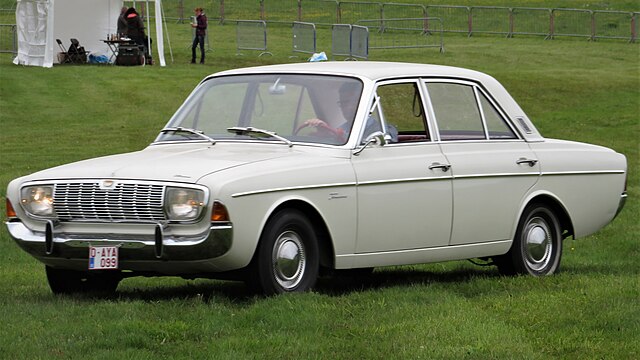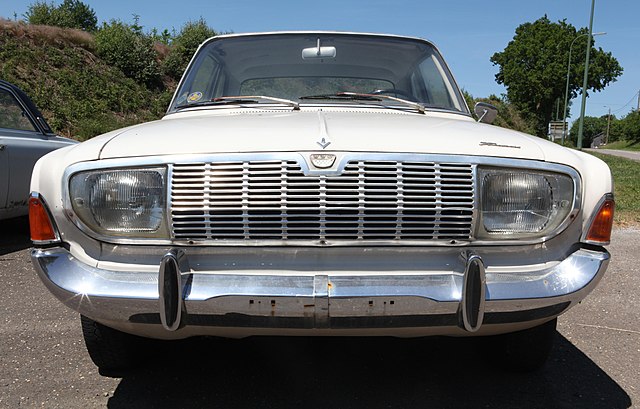Ford Germany Taunus P5
 c5,000 vehicles of all sub variants 1963-66
c5,000 vehicles of all sub variants 1963-66
About the Ford Taunus
The Ford Taunus was a family car sold by Ford Germany throughout Europe, with a production started in 1939, with the Taunus G93A as a development of the Ford Eifel, interruptd in 1942 and resumed in 1948 after the end of the British occupation. 7,128 pre-war G93A were made and 76,590 post-war, called G73A. The came the Taunus M-series (1952–1968), with the sub-variants "M" standing for "Meisterstück" ("Masterpiece"). The 12M, 15M, and 17M models had a sidevalve (flathead) and then overhead-valve design engine. From 1962 came the V4 engine and by late 1964 appeared the larger 17M/20M prized by civilian services.

From 1970 onward the models started to derived from the Ford Cortina MkIII and only changed by the locations of the steering wheel. The model was initially named after the Taunus mountain range in Germany, and the series went on until 1994. However we are only concerned by the truly unique Taunus P5 here.
Ford P5 Specifics
 Dashboard of the 17M Granada Turnier
Dashboard of the 17M Granada Turnier
The P5 was also called 17M and was considered the 3rd generation. It is often assimilated to the 20M, both being produced from 1964 to 1967.
The 1966 Ford Taunus 20M P5 had a new body and new engines whereas the 17M had V4 engine, either the 1.5 litre: 1498 cc, 60 hp (44 kW), 140 km/h (88 mph) or the 1.7 litre: 1699 cc, 65, or 70 hp (48 or 51 kW) capable of 145-150 km/h (91 or 94 mph). Later the 20M got a V6 engine, 1.8 litres, 82 hp, or 2.0 litres (1998 cc) 85-90 hp (63-66 kW) for a top speed of 158 or 161 km/h (99 or 101 mph) and it sold well. It's large size and many options made it a favourite of the US stationed in Berlin as well, especially the Constabulary forces.
The Ford Taunus 17 M was presented in September 1964 as a middle-weight family saloon and sedan that, manufactured by Ford Germany between 1964 and 1967. Production really started in November in two and four door. The "Turnier" (estate/station wagon) was presented in turn by January 1965 and later a new coupé 17M is retrospectively assimilated to the P5, being the fifth newly designed German Ford launched after the war and known internally by the Ford corp. as the Ford Project 5.
Being slightly larger overall externally compared to its predecessor, in many respects it was a toned down evolution compared to the “Badewannetaunus”. There was under the hood or bonnet a larger range of engines, mostly V4 and a single V6 engine, a bnovelty in germany for sedans. The Ford Taunus P5 was still the least expensive 6-cylinder. This partly expressed why it became a favourite of German civilian services.
As far the design went, the Taunus P5 presented a modern monocoque tri-corps design, but more conservative than its predecessor. There were still no round headlamps and its rear panel was bathtub-like, for which the “Wanne” (Tub) as per “Badewanne” for the P3 was no longer a fearture. Instead the P5 looked like a "committee design" seen as "boring" by the the automotive press, not enthusiastic for promoting a new catchy nickname for this one. Bodies were the 2-door, 4-door saloon, 3-door or 5-door “Kombi” estate car, 2-door coupé and 2-door coach-built (Karl Deutsch cabriolet).
Engine and Performances
 17M "super M" calander
17M "super M" calander
The Taunus moslty came with four-cylinder engines when badged 17Ms wheras the six-cylinder were badged as Taunus 20Ms and they had over-square cylinder dimensions.
The most basic came out with a 1,498 cc V4 engine shared with the “Cardinal” Taunus P4. This 1699 cc unit was superseded by a new 1498 cc with the same 90 mm (3.5 in) bore but longer stroke for respectively 60 PS (44 kW; 59 hp) and 70 PS (51 kW; 69 hp) at 4,500 rpm. The 1699 cc claimed 75 PS (55 kW; 74 hp).
The new V6 engine was a development from the V4, with two more cylinders for 1998 cc rated for 85 PS (63 kW; 84 hp) and with a higher compression ratio up to 90 PS (66 kW; 89 hp) at 5,000 rpm, standard twin carburetters.
The P5 also came with the “Startautomatik” automatic choke gearbox appearing on the 17M but the standard was a manual 3+1 speed gearbox. Still the V6 was sold at 7,990 Marks quite low for a V6 at the time, making it very popular. It was way cheaper than the Kapitän Opel Rekord (March 1964) for example. The standard was a rear wheels transmission by a three-speed all-synchromesh manual gear box conected by a column-mounted lever. There was an optional four-speed gearbox and the 3-speed fully automatic “Taunomatik” transmission based on the "Fordomatic" from May 1966. The P5 also had front disc brakes with rear drum brakes but with servo-assistance standard for the 20M. Suspensions used MacPherson struts forward, bream axle suspended on leaf springs back but with a wider track for improved handling. The was a six-volt electrical system, replaced by a 12 V from 1967.

Ford Taunus P5 20M (1963) |
| Dimensions (L-w-h) | 4,585 x 1,715 x 1,480–1,500mm (180.5 in x 67.5 in x 58.3–59.1 in) |
| Wheelbase | 2,705 mm (106.5 in) |
| Curb weight | 965–1,150 kg (2,127–2,535 lb) |
| Crew | 1 driver, 3-4 passengers |
| Propulsion | V6 1998 cc 85-90 PS (63/66 kW; 84/89 hp) 5000 rpm |
| Transmission | Ford Startautomatik or manual 3+1 |
| Top speed | 120 kph |
| Maximum range | c700 km |